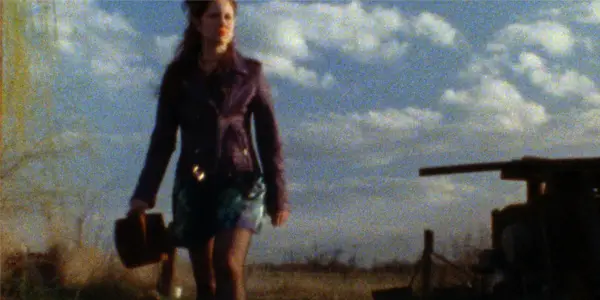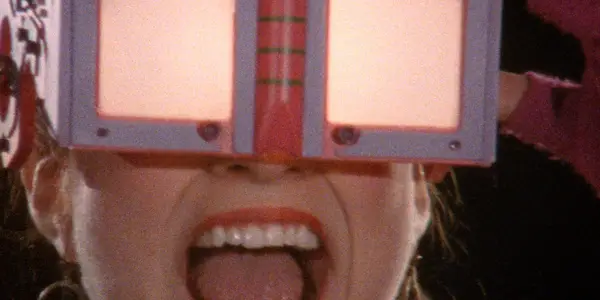HOW THE SKY WILL MELT: An Atmospheric Trip From First-Timer Matthew Wade

Jax is a filmmaker and producer, and a film &…
I sat down to watch independent, experimental film How the Sky Will Melt by Matthew Wade the other night with my fiance. Other than bragging about my fiance, I’m including him in the article because he is so very not like me. His favourite movies are comedies, he laughs at fart jokes, and I’m not sure he’s ever seen a David Lynch movie. But he loves movies. Next to him on the couch: PhD student in experimental cinema, little old me. What began was an introspective journey we both thoroughly enjoyed. Wade carefully unfolds an extremely human, critical, and ultimately tragic story.
Plot
The film follows Gwen (Sara Lynch), a young musician apparently just returned to her tiny home town from Los Angeles. Some unknown horrific event prompts the break-up of her band, her return to Idaho, and leaves Gwen in a state of near-catatonia. Days are spent wandering the barren hillsides and cemeteries with her unambitious friends, Pearl (Annika Karlsen) and London (Scott Alonzo), while nights find her glued to her rabbit-ear TV or “Magic Winks” – special goggles that play cassette tapes with an accompanying visual.

Things take a turn for the (even more) strange, when Gwen finds brightly coloured eggs (red, green, blue, and yellow) and a man falls from the sky, drenched in blood. Now caught between avoiding her past and confronting her present, Gwen becomes even more drawn into the media coma she’s created herself, but the Man From the Sky is demanding, “Feed me your colours.”
The Tech Specs
Well-paced, the film utilises dialogue sparingly, often with a tongue-in-cheek poke at life’s monotonous conversations. Beyond that there is a tremendous electronic score and soundscape that pulls the viewer into this dystopian representation of small-town life. The drab, rugged visuals support the overwhelming tone of isolation and the character’s feelings of loneliness. In general the cinematography is good, but every once in a while a really incredible image hits the screen. All of these elements are pulled together to create a palpable vibe that keeps you engaged in the action. Without the atmospheric tension, the film would be utterly unwatchable, but with it, you ask questions and demand answers.
I initially felt that the performances were a bit inexperienced and wooden at times, but the film really stuck with me and I kept turning it over in my head. I began to feel that the actors weren’t wooden but rather the characters were excessively bored, frustrated, and giving up. In the end, I decided that the readings were exactly what the film called for. It’s experimental film, you can’t apply the same rules you apply to a super-polished blockbuster and I wouldn’t want to. I did, however, feel that Scott Alonzo particularly shone in his role as London and that, considering her relative lack of dialogue (in comparison to most features), Sara Lynch does a great job of keeping the viewer interested.

Shot on 8mm film, the viewing experience can sometimes be reminiscent of home movies in a Brakhagian spirit (for some info on Stan Brakhage, check out my article on experimental film). This plays into the idea of different “realities” that seems to be present in the film – the reality of Los Angeles, represented in TV and flashback, the reality of the small town, the reality of the Magic Winks goggles. The extensive use of handheld in conjunction with the 8mm film stock heightens the perspective filmmaking. Sometimes it’s (perhaps intentionally) unclear whether we are seeing the film or a film within the film (i.e., footage from Magic Winks or TV).
On Another Level
Wade appears to be critical of how in tune we’ve become to various media devices. The tagline, “Feed me your colours” references the thematic representations of red, green, blue and yellow in the film, as well as spoken dialogue (one of the film’s many mysteries). RGB(y) are the cables we use to connect our video for viewing pleasure and I don’t think that’s a coincidence. In Wade’s own description of the film, he says that Gwen, Pearl, and London begin to “deteriorate the fabric of the universe.” Based on my viewing experience, I would say that Wade thinks the fabric of the universe is media, or at least it’s become that, and it is destroying us. Every negative event in Gwen’s life is related to media, whether it’s television, magazines, Magic Winks, or even phones.

The portrayal of media as a part of us brings themes from David Cronenberg’s Videodrome to mind as well as some of the work of Andy Warhol in the 60s and 70s. Still, Wade presents clues and puzzle pieces rather than a finished picture, and this lets us fill in our own blanks, allowing us to build on an established concept rather than simply re-hashing and re-telling it. Herein lies the films greatest strength: its absolute faith in its audience and their intelligence. The story is there to be found, but don’t expect to be spoon-fed. This is an audience participation film in the best sense.
A Final Thought
All in all, if you’re a fan of David Lynch’s more bizarre and atmosphere-driven works (i.e. Eraserhead, Lost Highway, Mulholland Drive) and perhaps early David Cronenberg or just experimental film in general, I think you’ll find How the Sky Will Melt interesting and thought-provoking. If, like my beloved, you are not familiar with those works, the film remains accessible and extremely intelligent without being obnoxious and is certainly worth a watch.
These are the kind of films that movie lovers need to be supporting. Forget “indie” cinema and “low-budget” films (that can mean millions of dollars in the budget still). It’s time for the rise of no-budget cinema. Matthew Wade and the cast and crew of How the Sky Will Melt made the film on a shoestring, with a bit of help from crowdfunding to complete the telecine. Currently the film is rounding the festival circuit and Wade has plans to distribute it via the internet. This is the time for us to doing this kind of film. Before it was easy to make films but difficult to get distribution to a wide audience. Distribution is at our fingertips. There are dozens of websites hosting shorts and features by young unknown talents. Start exploring.
You can follow Matthew Wade for more info on screenings and release of How the Sky Will Melt on Twitter @matthewmwade.
Interested in checking out the kind of films mentioned in this article? Try starting with It Shines and Shakes and Laughs, the first short film by Matthew Wade. Tell me what you think in the comments!
How the Sky Will Melt (teaser) from Matthew Wade on Vimeo.
Does content like this matter to you?
Become a Member and support film journalism. Unlock access to all of Film Inquiry`s great articles. Join a community of like-minded readers who are passionate about cinema - get access to our private members Network, give back to independent filmmakers, and more.
Jax is a filmmaker and producer, and a film & tv production lecturer at the University of Bradford and is also completing a PhD about Stan Brakhage at the University of East Anglia. In the remaining "spare time", Jax organises the Drunken Film Fest, binges bad TV, and dreams of getting “Bake Off good” with their baking.













